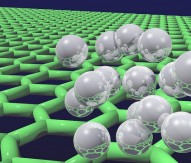
PROFILE: Creating new materials
Professor Marco Lattuada of the Adolphe Merkle Institute outlines how nanoparticles design can help in creating new materials.
Self-assembly is certainly not an invention of Man. Nature has been using the spontaneous organisation of a plethora of proteins and biomolecules for billions of years. Entire organisms are built by means of – and function thanks to – self-assembly. Compared to what Nature is capable of, our ability to exploit self-assembly is really limited. Nevertheless, molecular self-assembly has important technological applications. Detergents owe their properties to their capability to spontaneously form micelles and other complex phases. Liquid crystals are currently the most important component of LCD displays, widely used in computers.
On the other hand, the growing interest in nanotechnology, confirmed within the scope of Horizon 2020, led numerous researchers to investigate the self-assembly behaviour of nanoparticles. Thanks to their dimensions being comparable to biological entities, nanoparticles are ideal candidates to be used as building blocks. Materials constructed using nanoparticles can have novel properties imparted by them. Nanoparticles, nanoplatelets and nanotubes have already been used in preparing composite materials to enhance their mechanical properties, to impart flame resistance or to improve electric conductivity.
However, in order to make substantial leaps forward in the design of novel materials, and come one step closer to nature fantastic ability, a second generation of nanoparticles needs to be engineered. Not only do their size and shape have to be precisely controlled, but also their composition and surface functionality. Surface properties play a central role in determining nanoparticles behaviour, and are the major player in controlling their interactions and their self-organisation. Our group’s research activity tries to actively tackle these problems.
When compared to proteins and other biological molecules, one immediately realises that most nanoparticles typically possess uniformly functionalised surfaces, which is in sharp contrast with the well-defined and designed patchiness of proteins’ surfaces. Therefore it would be highly beneficial to create nanoparticles with well defined asymmetric composition and/or surface functionalisation patterns. Janus nanoparticles, i.e. two faces nanoparticles, are the simplest example of nanoparticles with surface asymmetrically functionalised. Such particles could either have hydrophobic-hydrophilic surfaces, thus imitating amphiphilic molecules (e.g. surfactants), or stimuli-responsive/non-responsive surfaces. Well defined asymmetry, for example imitating the behaviour of molecules and their ability to form directional bonds would enormously enhance the variety of structures accessible from their self-assembly. While examples of such nanoparticles have been reported in recent years, many synthetic hurdles still need to be overcome in order to make them suitable for commercial applications.
Nanoparticles with well defined asymmetric composition are also being investigated. The ability to combine into one single nanoscopic entity multiple materials in desired amounts and especially in precisely engineered locations is another goal of our research activity. The synthesis of nanoparticles made of immiscible polymers (pictured), or of a mixture of polymers and inorganic materials located in different compartments is currently being investigated. Each material brings its own unique properties, thus contributing to the formation of truly multifunctional nano-objects.
Guiding particles’ self-assembly via external force fields is another research direction currently pursued. In particular, superparamagnetic nanoparticles, which can develop strong dipolar interactions in response to the application of external magnetic fields, have been prepared. The assembly of such particles into one-dimensional, two-dimensional and even three-dimensional structures, driven by static or rotating magnetic field configurations has been investigated to prepare novel smart composite materials with unique architecture.
Designing such complex nanoparticles represents a step forward in the preparation of multifunctional materials with properties comparable to nothing that currently exists, and will open new possibilities in creating sensors, smart materials, vectors for drug delivery, etc.

Professor Marco Lattuada
University of Fribourg
tel: +41 263009525






